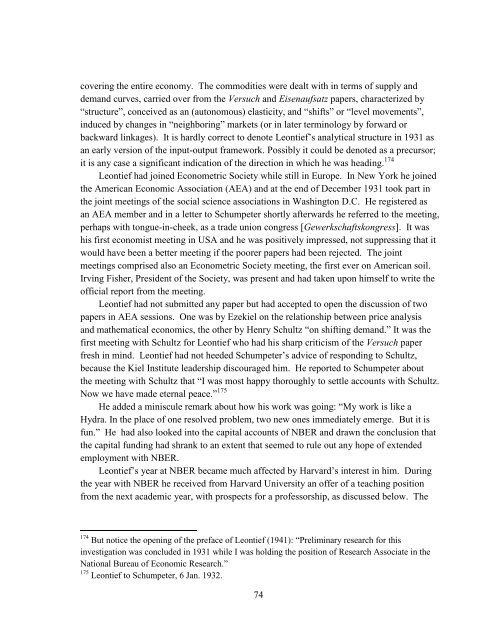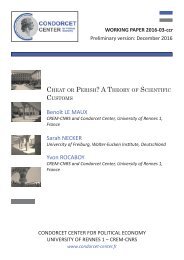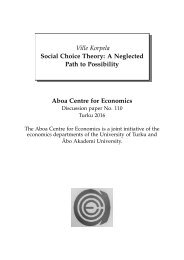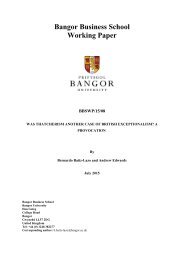MEMORANDUM
n?u=RePEc:hhs:osloec:2016_018&r=hpe
n?u=RePEc:hhs:osloec:2016_018&r=hpe
Create successful ePaper yourself
Turn your PDF publications into a flip-book with our unique Google optimized e-Paper software.
covering the entire economy. The commodities were dealt with in terms of supply and<br />
demand curves, carried over from the Versuch and Eisenaufsatz papers, characterized by<br />
“structure”, conceived as an (autonomous) elasticity, and “shifts” or “level movements”,<br />
induced by changes in “neighboring” markets (or in later terminology by forward or<br />
backward linkages). It is hardly correct to denote Leontief’s analytical structure in 1931 as<br />
an early version of the input-output framework. Possibly it could be denoted as a precursor;<br />
it is any case a significant indication of the direction in which he was heading. 174<br />
Leontief had joined Econometric Society while still in Europe. In New York he joined<br />
the American Economic Association (AEA) and at the end of December 1931 took part in<br />
the joint meetings of the social science associations in Washington D.C. He registered as<br />
an AEA member and in a letter to Schumpeter shortly afterwards he referred to the meeting,<br />
perhaps with tongue-in-cheek, as a trade union congress [Gewerkschaftskongress]. It was<br />
his first economist meeting in USA and he was positively impressed, not suppressing that it<br />
would have been a better meeting if the poorer papers had been rejected. The joint<br />
meetings comprised also an Econometric Society meeting, the first ever on American soil.<br />
Irving Fisher, President of the Society, was present and had taken upon himself to write the<br />
official report from the meeting.<br />
Leontief had not submitted any paper but had accepted to open the discussion of two<br />
papers in AEA sessions. One was by Ezekiel on the relationship between price analysis<br />
and mathematical economics, the other by Henry Schultz “on shifting demand.” It was the<br />
first meeting with Schultz for Leontief who had his sharp criticism of the Versuch paper<br />
fresh in mind. Leontief had not heeded Schumpeter’s advice of responding to Schultz,<br />
because the Kiel Institute leadership discouraged him. He reported to Schumpeter about<br />
the meeting with Schultz that “I was most happy thoroughly to settle accounts with Schultz.<br />
Now we have made eternal peace.” 175<br />
He added a miniscule remark about how his work was going: “My work is like a<br />
Hydra. In the place of one resolved problem, two new ones immediately emerge. But it is<br />
fun.” He had also looked into the capital accounts of NBER and drawn the conclusion that<br />
the capital funding had shrank to an extent that seemed to rule out any hope of extended<br />
employment with NBER.<br />
Leontief’s year at NBER became much affected by Harvard’s interest in him. During<br />
the year with NBER he received from Harvard University an offer of a teaching position<br />
from the next academic year, with prospects for a professorship, as discussed below. The<br />
174 But notice the opening of the preface of Leontief (1941): “Preliminary research for this<br />
investigation was concluded in 1931 while I was holding the position of Research Associate in the<br />
National Bureau of Economic Research.”<br />
175 Leontief to Schumpeter, 6 Jan. 1932.<br />
74





